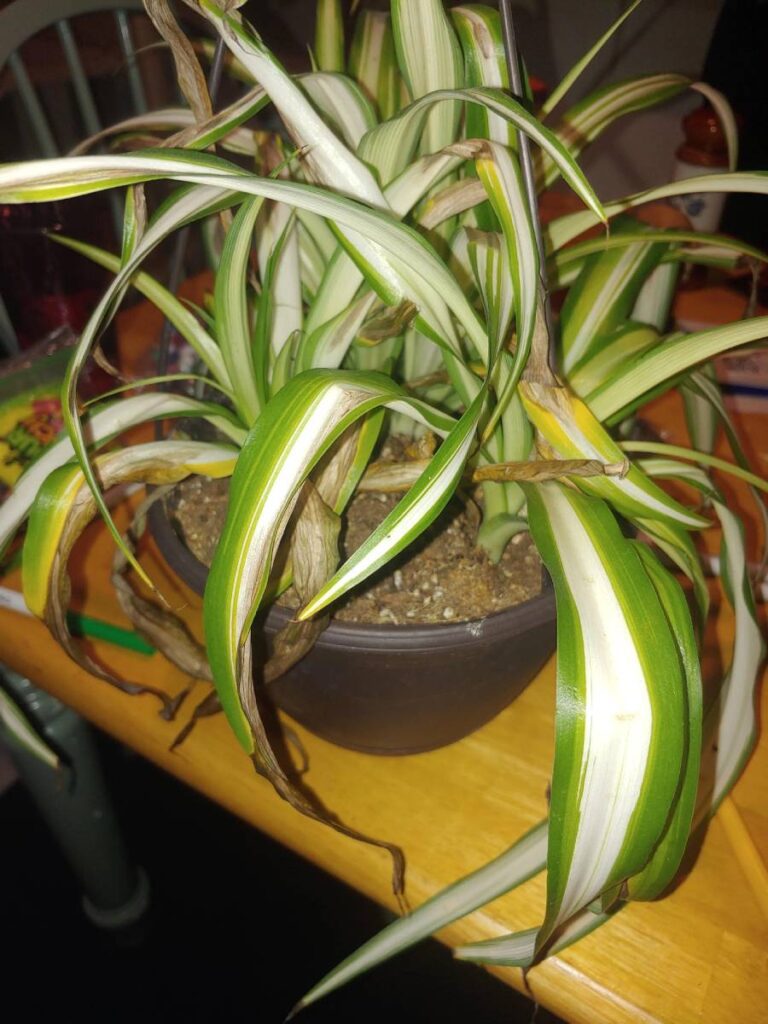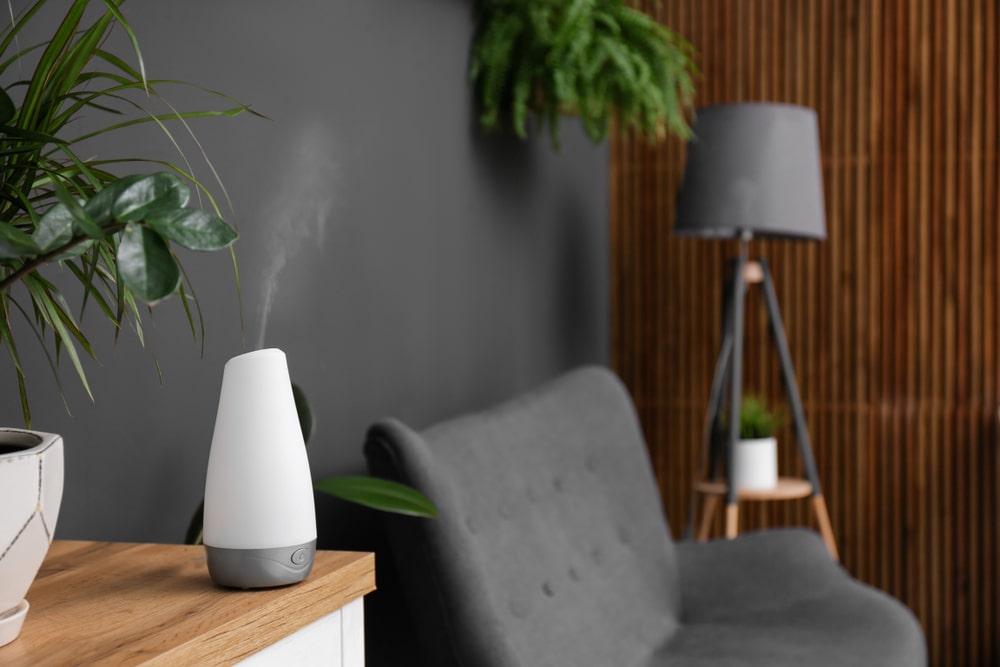Spider plants (Chlorophytum comosum) are easy to care for, resistant to pests and diseases, and (in my mind) look incredibly cute! However, like all plant babies, spider plants need their share of water in order to thrive.
So how often do you need to water your spider plants? Well, that depends on a number of variables: humidity levels in the room where it’s living, the size of your pot, and other conditions like soil type.
In this article, we’ll talk about how often you should water your spider plant as well as some tips to make sure none of those precious baby roots dry out.
Here’s How Often Do You Water a Spider Plant?
Spider plants should be watered once or twice a week, depending on the temperature and exposure to sunlight. Before watering, check the soil to see if it’s dry. If the tips of the leaves are dry and crispy, this may indicate underwatering, while dark brown tips may point to overwatering.

The Basics of Spider Plant Watering
To ensure your spider plant gets enough water without becoming overwatered, it’s important to understand the basics of watering. Aim to water your plant whenever the soil feels dry—usually every 7–10 days or so—but this can vary depending on the season and amount of indirect sunlight it receives.
To check if it needs watering, stick your finger into the top inch of soil; if it feels dry, then it’s time to give your plant some love!
When you do water your spider plant, make sure to do so thoroughly. Give it enough water so that it’s evenly distributed throughout the soil—not too much or too little! Overwatering can cause root rot due to waterlogged soil, so be sure to allow proper drainage after each watering.
How Much Water Does a Spider Plant Need?
Figuring out the perfect amount of water for your spider plant can be tricky. After all, too little or too much water can cause damage to the plant, so it’s important to find the sweet spot for keeping it happy and healthy.
Generally speaking, a spider plant needs about 1-2 inches of water per week during their growing season (spring and summer). During winter months, when growth slows down, you can reduce this to about half an inch per week.
The size of the pot and type of soil it’s planted in are also factors that will determine how much water is needed. However, doing a regular check on the soil moisture levels should give you a good indication of when your spider plant needs watering.
When you do water your spider plant, make sure that there is sufficient drainage at the bottom of its pot so that excess water doesn’t build up and cause root rot. A layer of gravel below the soil should provide extra drainage in order to prevent this from happening.
Assessing When Spider Plant Needs Watering
Assessing when a spider plant needs watering is an easy process that requires just a few pieces of information.
To start, you should check the soil. Stick your finger into the soil up to the second knuckle and feel around. If it’s still damp, then your plant doesn’t need to be watered yet; if it’s dry, then it’s time to give your spider plant a drink.
The environment also plays an important role in determining how often you should water your spider plant. If the air is dry and the temperature is warm, then your spider plant will likely need more water than usual. On the other hand, if the air is humid and cool, then you can probably wait a bit longer before giving it a drink.
The size of your spider plant also matters when it comes to watering frequency. Smaller plants have shallower root systems, and their soil dries out faster than that of larger plants with deeper roots. As such, they require more frequent watering than their larger counterparts.
By taking all these factors into consideration—soil moisture levels, environmental conditions, and size—you can easily assess when your spider plant needs to be watered and ensure that it gets just enough water for optimal health and happiness.
How Often to Water Spider Plant in Pots
For smaller pots, you should water your spider plant when the top inch of soil is dry. If you’re not sure if it’s time to water yet, it’s better to err on the side of caution and water less frequently but more thoroughly.
In larger pots, however, you may need to water more often as there is more soil that needs hydration. During summer months, when temperatures are higher, you may need to water twice a week; during colder months, once a week or even less might be enough.
Finally, if your soil mix contains components like peat or perlite, which absorb more moisture than other types of soil, you may need to increase your watering frequency accordingly.
Keeping an eye on these factors will help ensure that your spider plant stays healthy and happy!
How Often to Water Spider Plant in Hanging Baskets
When it comes to watering spider plants in hanging baskets, the key is to find the right balance between hydration and overwatering. As the container is suspended in the air, the soil can dry out faster than if it were in a pot.
To ensure your plant remains healthy and hydrated, you should water it every 4–7 days. The size of the basket will determine how much water is needed; larger baskets require more water than smaller ones.
Additionally, you should also take into account the climate; hotter and drier weather will necessitate more frequent watering.
When adding water, be sure to drench the soil until it is evenly moist. Doing this will guarantee that all of the roots are being adequately hydrated.
It’s also important to check for any signs of overwatering – if the soil looks soggy or smells musty, then you’ve likely added too much water.
To avoid this issue, make sure to monitor your plant’s soil moisture levels regularly and adjust your watering schedule accordingly.
Do Spider Plants Need Mist or Spray?
Misting your spider plant can be beneficial in certain circumstances. If you live in a dry climate or if your home tends to have low humidity levels, then misting your spider plant can help to keep it looking lush and healthy.
To mist your spider plant, fill a spray bottle with water and lightly spritz the foliage. Avoid misting the flowers, as this can cause damage.
You could also consider placing your spider plant near a humidifier or by an open window in the bathroom to increase humidity around the plant and help it stay healthy.
The Effects of Overwatering on Spider Plants
The effects of overwatering a spider plant can be quite severe. When too much water is given, the roots become waterlogged, and the plant can suffer from root rot. This often results in the leaves drooping, yellowing, and wilting, which can eventually lead to death if not addressed.
Moreover, overwatering can also cause fungal and bacterial diseases that further damage the plant. In addition to this, it can keep oxygen from getting to the roots, which can make the plant lack nutrients.
The key is to ensure that your spider plant has good drainage so that excess water doesn’t accumulate and cause these problems.
Provide plenty of drainage holes in the pot and make sure that the soil is well aerated before watering your spider plant—only do so when the top layer of soil is dry!
The Impact of Temperature on How Often You Should Water a Spider Plant
The temperature of the environment your spider plant is kept in can have a dramatic effect on how often you should water it.
If the temperature is cooler, then the soil will take longer to dry out, so you should wait longer between watering sessions. On the other hand, if the air is warmer, then the soil will dry out faster and require more frequent watering.
It’s important to note that if your spider plant is kept in a particularly warm environment, then you should reduce the amount of water you give it each time. This is because warm air causes water to evaporate quickly, resulting in overly wet soil and potential root rot.
When deciding how often to water your spider plant, it’s best to use your finger as a guide. Stick it into the top layer of soil and see if it feels dry; if so, then it’s time for another watering session!
Keep in mind that this can vary depending on the temperature and humidity of your space; for example, if it’s very humid, you may need to wait longer before watering again.
Overall, when caring for a spider plant, it’s important to keep an eye on both temperature and moisture levels. By doing so, you’ll be able to provide your plant with the perfect balance of water and warmth it needs to thrive.
Soil’s Influence on the Frequency of Watering for a Spider Plant
The frequency of watering for a spider plant is largely influenced by the type of soil it is planted in. Potting soil that is high in organic matter will retain water for longer, meaning you won’t have to water as often. On the other hand, soil that is low in organic matter can dry out quickly, requiring more frequent watering.
To get the best results, you may want to consider using a potting mix specifically designed for spider plants or adding some organic material like compost or peat moss to your existing soil.
It’s also important to keep an eye on temperature and humidity levels when caring for a spider plant. If the air is warmer, then the soil will dry out faster and require more frequent watering sessions; if it’s cooler, then you should wait longer between each session.
Additionally, if your spider plant is kept in a particularly warm environment, then you should reduce the amount of water you give it each time as warm air causes water to evaporate quickly, which can lead to root rot.
Finally, if your potting soil has been left in a pot for too long, it can become compacted and unable to hold water properly. In this case, it’s best to repot your spider plant in fresh soil to ensure that it can get the moisture it needs.
Fertilizing Your Spider Plant and Its Impact on Water Frequency
Fertilizing your spider plant is an important part of its care, and it can also have an impact on the frequency of watering.
During the growing season, spider plants should be fertilized once every two months with a balanced fertilizer that is diluted to half the strength recommended on the package.
It’s important to water your plant before and after applying fertilizer, as this will help ensure that the nutrients reach the roots and aren’t washed away.
Over-fertilizing can cause the soil to become too dense, which can prevent water from reaching the roots and lead to stress in your plant. Be sure to follow all instructions on the fertilizer package for best results.
When winter arrives and the growing season ends, you may find yourself needing to adjust your watering schedule for your spider plant. As it isn’t actively growing anymore, it won’t need as much water as before.
You can reduce how often you water or even stop altogether if your plant is in a dormant state—just make sure to keep an eye on things and watch out for any signs of wilting or drying out. If you notice any changes in your plant’s condition, be sure to adjust accordingly!
The Benefits of Using Rainwater for Your Spider Plant
Using rainwater for your spider plant has tremendous benefits. This is because rainwater has the perfect pH balance for spiders, while also providing all sorts of nutrients that could give your spider plant an added boost in health if you haven’t been able to fertilize it recently.
It’s also free of any chemicals or contaminants that can be found in tap water, meaning you don’t have to worry about potentially exposing your plant to harmful elements.
Furthermore, it has a lower sodium content when compared to regular tap water; this helps prevent salt buildup in the soil and keeps the roots healthy. You will also not have to worry about wilting or discolored leaves!
f rainwater is unavailable, filtered tap water can be used as an alternative; just make sure to check its pH level beforehand as it might be too acidic or alkaline for optimal growth.
Finally, make sure not to over-water your spider plant since that can lead to root rot and other issues; only give them water when the soil dries out and never enough so some moisture still remains at the bottom of the pot after draining off excess liquid.
Signs that Your Spider Plant Is Thirsty and Needs More Water
It’s important to be mindful of when your spider plant needs a bit more water. To know when this is, there are few telltale signs that can clue you in.
For instance, if the leaves of your spider plant look droopy or wilted and they’re curling inward, it’s likely that your plant needs some hydration. You can also check just beneath the surface to feel if the soil is dry. Additionally, you might see that the color of the leaves have taken on a lighter tone.
Once you spot any one of these indicators, it means that your spider plant is thirsty and needs more water immediately. If it’s been a while since you last gave it moisture, give it a thorough soaking, as this will help revitalize your spider plant’s roots.

Tips for Keeping Your Spider Plant Healthy with Proper Hydration
Proper hydration is an essential part of keeping your spider plant healthy. Here are some tips to help you make sure your plant is getting the right amount of water:
• Make sure your potting soil is damp—not too wet or too dry. If it feels dry, then it’s time to water your plant.
• Use a watering can or hose with a nozzle attachment to water the top of your pot directly.
• Water until you see the excess coming out from the bottom of the pot.
• Don’t let your spider plant sit in standing water; make sure there are drainage holes in the bottom, and be sure to empty any built-up liquid afterwards.
• If the soil is very dry, try submerging the entire pot in a bucket or bowl full of fresh water for several minutes; this will help rehydrate the soil more easily and quickly.
Summary: Ideal Frequency for Watering Your Spider Plant
When it comes to watering your spider plant, there are many factors to consider in order to get the best results. The size of your plant matters, as do the type of soil and pot it’s in, along with the temperature and humidity levels inside your home.
However, generally speaking, you should water your spider plant when the top inch of soil is dry. So if you notice that it’s still damp after a few days, then wait until it has dried out before giving it a drink. It’s recommended to do this every 1–2 weeks for optimal results.
You should also be aware of how your plant is looking on a regular basis. If the leaves droop or become discolored, then it could indicate that your spider plant needs more water.
To sum up, fluctuating factors mean there isn’t a fixed amount of time for how often you should water your spider plant—but aiming for 1 to 2 weeks should give you plenty of leeway and reduce any risk of overwatering or underwatering it. Keep an eye on both the soil and leaves and adjust accordingly.







